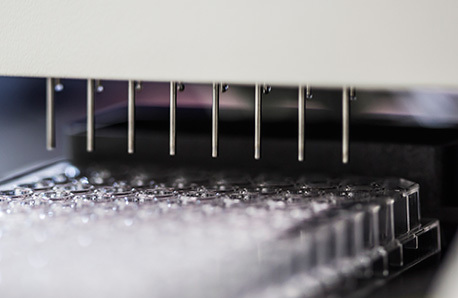Tests
EliSpot
EliSpot, ook wel T-Spot genoemd, is een technologie die wordt gebruikt om de functionele immuunrespons van T-cellen op verschillende antigenen te beoordelen met behulp van enzymgebonden immuno-spotassays.

Diagnostische opties met EliSpot
Ons laboratorium maakt gebruik van EliSpot als een van onze belangrijkste technologieën om cellulaire immuniteit te meten en te helpen bij de diagnose van verschillende moeilijk te detecteren infecties.
Een breed scala aan te testen ziekten:
De EliSpot maakt het mogelijk om een verscheidenheid aan infecties en pathogenen te onderzoeken, waaronder bekende agentia zoals Ehrlichia & Anaplasma, Bartonella, Babesia, evenals virale infecties veroorzaakt door het Epstein-Barr-virus (EBV), herpes simplex-virus, cytomegalovirus en anderen.
Diep inzicht in het immuunsysteem:
Door de cellulaire immuunrespons te meten, biedt de EliSpot niet alleen de mogelijkheid om de werkzaamheid van therapieën te monitoren, maar levert ook inzicht in T-cel-gemedieerde immuunresponsen bij verschillende infecties. De hoge gevoeligheid en specificiteit maken het een waardevol hulpmiddel bij de diagnose en monitoring van infectieziekten.
EliSpot – Een veelzijdig hulpmiddel in de diagnostiek van infectieziekten:
Ons laboratorium maakt gebruik van EliSpot-technologie om een breed scala aan infecties te diagnosticeren en te monitoren. Door de brede toepasbaarheid en het vermogen om de cellulaire immuunrespons nauwkeurig vast te leggen, draagt de EliSpot aanzienlijk bij aan de precieze diagnose en behandeling van infectieziekten.
De Borrelia EliSpot kan enkele problemen oplossen
- De test geeft de werkelijke Borrelia burgdorferi activiteit van chronische en recente Borrelia burgdorferi infecties weer.
- De EliSpot is zeer gevoelig en kan zelfs één reactieve T-cel detecteren. Met detectiegevoeligheid van slechts een cel op 100,000, is de EliSpot een van de meest gevoelige cellulaire testen die beschikbaar is.
- De EliSpot is tussen 20 en 200 maal gevoeliger dan een conventionele ELISA.
- De EliSpot toont een vergelijkbare gevoeligheid als RT-PCR (Real Time PCR) analyse, maar detecteert het uitgescheiden eiwit in plaats van het mRNA (messenger RNA).
- De EliSpot kan nuttig zijn bij het monitoren van therapieën. De EliSpot wordt gewoonlijk 4 tot 8 weken na het voltooien van een effectieve therapie negatief.
Wat kan er worden getest met de EliSpot?
Lymeziekte
Infecties met Borrelia burgdorferi roepen niet alleen een humorale immuunrespons op in de vorm van Borrelia-specifieke antilichaamproductie, maar activeren ook gelijktijdig de cellulaire immuunrespons in de vorm van specifieke T-lymfocyten (EliSpot-test). Zodra Borrelia niet meer actief zijn in het lichaam, zou de T-cellulaire immuunrespons snel moeten afnemen, wat resulteert in een negatieve EliSpot-test.
Het is over het algemeen niet mogelijk om het succes van een effectieve therapie voor Lymeziekte te beoordelen met behulp van Borrelia-antilichamen, omdat de antilichaamtiter in het bloed jarenlang aanwezig kan blijven. Onlangs verworven infecties met Borrelia burgdorferi (bijvoorbeeld symptomen van erythema migrans of zomergriep na een tekenbeet) manifesteren zich vaak weken later in de vorm van antilichaamproductie. Bovendien kan de detectie van Borrelia-specifieke antilichamen negatieve resultaten opleveren ondanks een actuele infectie, vanwege ontoereikende standaardisatie en lage gevoeligheid van ELISA- en immunoblot-tests. In dergelijke gevallen kan de Borrelia EliSpot-test vaak de diagnostische kloof overbruggen.
De Borrelia EliSpot kan enkele van deze problemen aanpakken.
- De test weerspiegelt de huidige activiteit van de pathogeen bij zowel chronische als verse/acute infecties (opmerking: erythema migrans of zomergriep na een tekenbeet) met Borrelia burgdorferi.
- De EliSpot is zeer gevoelig en kan zelfs één enkele T-cel detecteren die reageert op Borrelia burgdorferi. Met detectiegrenzen tot één cel in 100.000 is de EliSpot een van de meest gevoelige cellulaire testmethoden die beschikbaar zijn.
- De EliSpot is tussen de 20 en 200 keer gevoeliger dan een reguliere ELISA-antilichaamtest.
- Daarom is de EliSpot vergelijkbaar gevoelig als een RT-PCR-test (Real Time PCR), maar detecteert het het pathogeen-eiwit in plaats van het mRNA (messenger RNA).
- De EliSpot kan nuttig zijn bij het monitoren van therapieën. Deze zou doorgaans negatief moeten worden 4 tot 8 weken na het einde van een effectieve therapie.
Borrelia EliSpot
T-Cell-Spot / IGRA: Interferon-Gamma-Release Assay
Borrelia EliSpot antigenen:
- Borrelia burgdorferi Volledig Antigeen: Borrelia burgdorferi B31-referentiestam (Borrelia burgdorferi sensu stricto)
- Borrelia burgdorferi Peptide-Mix: OspA van Borrelia b. sensu stricto, Borrelia afzelii, Borrelia garinii + OspC native + DbpA recombinanten
- Borrelia burgdorferi LFA-1 (Lymphocyte Function Antigen 1): Eigen lichaamsproteïne + Borrelia burgdorferi sensu stricto (gedeeld epitoop). Vaak geassocieerd met auto-immuunziekten: collagenose, Reumatoïde Artritis, vasculitis (ANA, CCP-antilichamen, ANCA)
Uitleg: Native = gekweekte antigenen / Recombinanten: genetische technologie geproduceerd
Reflectie van de huidige T-cellulaire activiteit van Lymeziekte:
- Indicatie voor een momenteel actieve Borrelia burgdorferi-infectie in gevallen van verder positieve EliSpot na het einde van therapieën
- T-Cell-Spot/IGRA is in mei 2011 door de FDA goedgekeurd voor M. tuberculosis: “… Een positieve uitslag suggereert dat een infectie waarschijnlijk is, een negatieve uitslag suggereert dat een infectie onwaarschijnlijk is…” “…Resultaten kunnen binnen 24 uur beschikbaar zijn…”
EliSpot: Nieuwe T-Cell Test een “Game Changer” voor Lymeziekte:
- De gevoeligheid van EliSpot wordt geschat op 84% en de specificiteit op 94%.
- EliSpot-assays bieden robuuste, hoog reproduceerbare gegevens.
- EliSpot kan opnieuw worden getest voor de verkrijging van aanvullende informatie in vervolgtests.
- De twee testsystemen (EliSpot + CD57-celtelling) vullen elkaar aan in de zoektocht naar het begrijpen van T-cel-gemedieerde immuniteit in vivo.
Hoofdartikel in het "Clinical Infectious Diseases Journal"
Referenties:
Lehman PV et al.: Unique Strengths of EliSpot for T Cell Diagnostics in: Kalyuzhny AE. Handbook of EliSpot: Methods and Protocols, Methods in Molecular Biology, Vol. 792. 2nd Ed: Springer; 2012: 3-23
